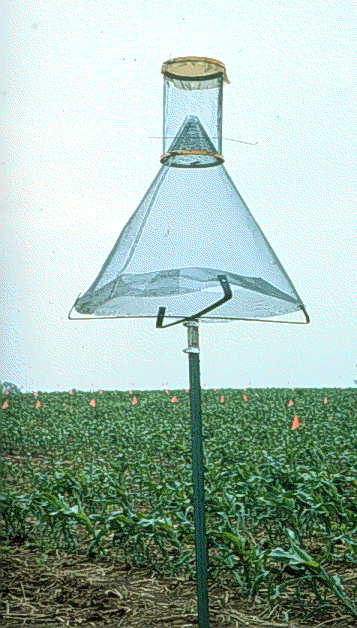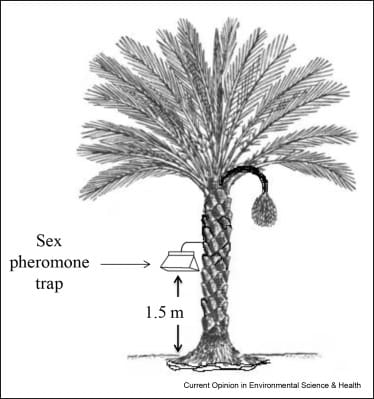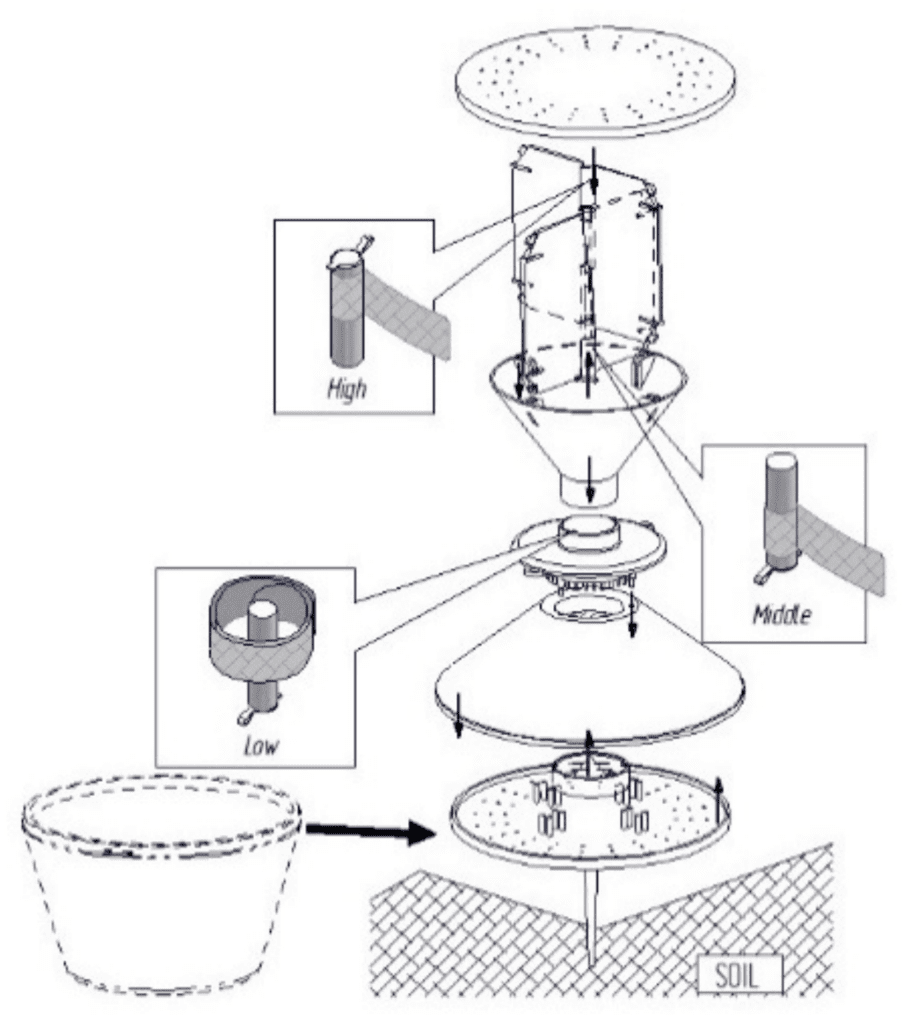Imagine a world where pests are easily controlled without the need for harmful chemicals or expensive exterminators. Well, thanks to the fascinating science behind pheromone traps, that world is becoming a reality. Pheromone traps utilize the power of naturally occurring chemical signals to lure pests into a trap rather than your home or garden. In this article, we will explore the fascinating science behind pheromone traps and how they can revolutionize the way we tackle pest control. Get ready to discover a smarter and more eco-friendly solution to keep those unwanted visitors at bay!
Understanding Pheromones
What are pheromones?
Pheromones are chemical substances that are produced and released by organisms, including insects, in order to communicate with others of their species. These chemical signals play a vital role in insect behavior, particularly in their reproductive and foraging activities. Pheromones can be emitted by both males and females and are used to attract mates, mark territorie, and signal alarm. They are often species-specific, meaning that they are only recognized and responded to by individuals of the same species.
The role of pheromones in insect communication
Insects rely heavily on pheromones to communicate with each other. For example, female insects release sex pheromones to attract males and signal their availability for mating. This helps to ensure successful reproduction and continuation of the species. Additionally, pheromones are used by insects to mark territory and establish dominance, which can prevent conflicts among individuals.
How pheromones attract and repel insects
Pheromones play a crucial role in attracting and repelling insects. When a female insect releases sex pheromones, they travel through the air and can be detected by males from a distance. The males are then able to locate the females and mate with them. On the other hand, pheromones can also be used to repel insects and act as a warning signal. For example, when an insect is attacked by a predator, it may release an alarm pheromone to alert nearby individuals of the danger and prompt them to take evasive action.
Different types of pheromones and their functions
There are several different types of pheromones that insects use for various functions. Some of the common types include sex pheromones, aggregation pheromones, alarm pheromones, and trail pheromones. Sex pheromones are used to attract mates, while aggregation pheromones are emitted by insects to attract others of the same species to a specific location. Alarm pheromones, as mentioned earlier, are released when an insect is threatened, and trail pheromones are used by social insects, such as ants, to mark paths and guide others to food sources.
Working Mechanism of Pheromone Traps
Overview of pheromone traps
Pheromone traps are tools used in insect pest management to monitor and control populations of specific pest species. They are designed to mimic the natural pheromones produced by insects and exploit their strong attraction to these chemicals. By using pheromone traps, it is possible to trap and monitor the presence and abundance of pest species, as well as reduce their population through attrition.
Components of a typical pheromone trap
A typical pheromone trap consists of several components working together to attract and capture insects. These components include a lure or bait containing synthetic pheromones, a trap housing that provides a suitable environment for trapping, and physical barriers or sticky surfaces to prevent the escape of trapped insects. The lure or bait is the key component that emits the synthetic pheromones and attracts the target pest species.
How pheromone traps mimic natural pheromones
Pheromone traps are designed to closely mimic the natural pheromones emitted by insects. Synthetic pheromones that are specific to the target pest species are used in the traps to maximize their attractiveness. These synthetic pheromones are chemically similar to the ones naturally produced by insects, which allows them to effectively lure and trap the target pests.
Attracting specific pest species with pheromone traps
Pheromone traps are highly effective in attracting and trapping specific pest species. This is because the synthetic pheromones used in the traps are tailored to the specific pheromone composition of the target pests. By using the correct pheromone blend, traps can specifically attract the target pests while minimizing the attraction of non-target species. This targeted approach makes pheromone traps a valuable tool in integrated pest management strategies.

Benefits of Using Pheromone Traps
Environmental friendliness of pheromone traps
One of the major benefits of using pheromone traps in insect pest management is their environmental friendliness. Unlike chemical insecticides, which can have adverse effects on the environment and non-target organisms, pheromone traps are specific to the target pest species and have minimal impact on beneficial insects, birds, and mammals. This makes them a sustainable and eco-friendly solution for pest control.
Reduced pesticide usage and its impact on human health
By using pheromone traps, the reliance on chemical insecticides can be reduced. This has several positive effects, including reduced exposure to harmful pesticides for both workers and consumers. Pesticide residues on food can be a health concern, but with the use of pheromone traps, pesticide usage can be minimized, resulting in safer food production and consumption.
Targeted pest control for efficient management
Pheromone traps allow for targeted pest control, focusing on specific pest species rather than blanket application of insecticides. This targeted approach is more efficient and cost-effective, as it reduces the use of chemicals and minimizes the impact on non-target organisms. By specifically targeting the pest species, it is possible to disrupt their mating and breeding patterns, leading to a significant reduction in population size.
Non-toxic nature and safety around children and pets
Another advantage of pheromone traps is their non-toxic nature, making them safe to use around children and pets. Since pheromone traps do not rely on toxic chemicals to control pests, they pose minimal risk to humans and animals. This is particularly important in residential areas and agricultural settings where families and animals may be exposed.
Developing Effective Pheromone Traps
Research-based design and formulation
The development of effective pheromone traps relies on scientific research and understanding of the target pest species. By studying the behavior and pheromone composition of the pests, researchers can design traps that accurately mimic their natural pheromones. This research-based approach ensures that the traps are highly attractive to the target pests and maximizes their effectiveness.
Factors influencing trap effectiveness
Several factors can influence the effectiveness of pheromone traps. These include trap design, pheromone blend, timing of trap deployment, and trap placement. The design of the trap housing, the quality of the synthetic pheromones used, and the timing of trap deployment during the insect’s life cycle are important considerations for trap effectiveness. Additionally, trap placement in strategic locations, such as near breeding areas or along insect migration paths, can greatly enhance trapping success.
Optimizing trap placement and density
Proper trap placement and density are crucial for maximizing the efficacy of pheromone traps. Placing traps in areas where pest activity is high, such as near plants or crops that are susceptible to infestation, can increase the chances of trapping the target pests. The density of traps should also be optimized based on the size and characteristics of the infested area. By strategically placing traps, it is possible to monitor and control pest populations more effectively.
Periodic trap maintenance and monitoring
Regular maintenance and monitoring of pheromone traps are important for their long-term effectiveness. Traps should be inspected regularly for any damage, such as clogging of the sticky surfaces or deterioration of the lures. Additionally, the captured insects should be collected and counted periodically to monitor population levels and assess the effectiveness of the traps. Proper trap maintenance and monitoring are essential for achieving optimal results.

Commercially Available Pheromone Traps
Pheromone trap brands and manufacturers
There are several brands and manufacturers that produce pheromone traps for insect pest management. Some popular brands include XYZ Pest Control, ABC Traps, and PQR Pest Solutions. These companies have extensive experience in the field and offer a wide range of trap options for different pest species.
Various trap designs and features
Pheromone traps come in various designs and offer different features to suit different pest management needs. Some traps are designed for monitoring purposes, while others are specifically designed for population reduction. Trap designs can vary from simple sticky traps to more complex designs that incorporate additional attractants and lures. The choice of trap design depends on the target pest species and the intended purpose of the trap.
Choosing the right pheromone trap for specific pests
When selecting a pheromone trap, it is important to choose the right trap for the specific pest species that needs to be controlled. Different pests have different pheromone compositions and attractant preferences, so it is important to select a trap that matches their specific characteristics. Consulting with pest management professionals or referring to research-based guidelines can help in choosing the most appropriate pheromone trap for a particular pest.
Effectiveness and customer reviews
The effectiveness of pheromone traps can vary depending on several factors, such as the target pest species, trap design, and environmental conditions. It is important to consider customer reviews and feedback when evaluating the effectiveness of different trap brands and models. Reviews from other users can provide valuable insights into the performance and reliability of specific pheromone traps.
Integration with Integrated Pest Management (IPM) Strategies
Understanding the concept of IPM
Integrated Pest Management (IPM) is an approach to pest control that emphasizes the use of multiple strategies to manage pest populations. It involves the integration of various pest control methods, including biological control, cultural practices, and chemical control, in a comprehensive and sustainable manner. IPM aims to minimize the use of chemical pesticides and maximize the use of environmentally friendly pest control techniques.
Role of pheromone traps in IPM
Pheromone traps play a significant role in integrated pest management strategies. They provide a non-toxic, targeted approach to pest control that is compatible with other IPM methods. By using pheromone traps, it is possible to monitor pest populations, detect infestations early, and reduce the need for chemical insecticides. Pheromone traps also help in identifying the timing and intensity of pest outbreaks, allowing for more precise and effective control measures.
Combining pheromone traps with other control methods
To achieve optimal pest control, pheromone traps can be combined with other control methods within an integrated pest management program. For example, biological control agents, such as beneficial insects or pathogens, can be used in conjunction with pheromone traps to further reduce pest populations. Cultural practices, such as crop rotation or sanitation measures, can also be integrated to create an overall pest management strategy that is effective and sustainable.
Enhancing long-term pest management
By integrating pheromone traps into an IPM program, long-term pest management can be enhanced. Pheromone traps provide valuable information on pest population dynamics, allowing for timely interventions and preventive measures. Through continuous monitoring and trapping, it is possible to maintain pest populations at levels that are below economic thresholds, minimizing crop damage and the need for intensive pesticide applications.

Limitations and Challenges of Pheromone Traps
Effectiveness for certain pest species
While pheromone traps are highly effective for many pest species, they may not work as well for certain pests. Some insects may be less responsive to synthetic pheromones, making it difficult to attract and trap them. Additionally, there may be variations in the pheromone composition of a particular pest species, leading to fluctuations in trap effectiveness. Research and ongoing monitoring are necessary to address these limitations and refine trap formulations.
Environmental factors affecting trap performance
Environmental factors can significantly influence the performance of pheromone traps. Factors such as wind direction and speed, temperature, humidity, and the presence of competing odors can impact the dispersion and detection of pheromone plumes. In unfavorable conditions, the efficacy of pheromone traps may be reduced, requiring adjustments in trap placement or the use of alternative control methods.
Pheromone trap maintenance and cost
Pheromone trap maintenance can be labor-intensive and costly, particularly in large-scale agricultural operations. Traps need to be regularly inspected, cleaned, and replaced with fresh lures to ensure their effectiveness. Additionally, the cost of purchasing and replacing pheromone lures can be a significant expense. Despite these challenges, the benefits of reduced pesticide use and more sustainable pest management outweigh the costs for many growers and pest control professionals.
Addressing limitations for optimal results
To address the limitations and challenges associated with pheromone traps, ongoing research is necessary. This includes studying the specific pheromone compositions and responses of different pest species, as well as refining trap designs and formulations. By continuously improving trap effectiveness and addressing limitations, it is possible to optimize the use of pheromone traps in pest management and achieve better results.
Case Studies and Success Stories
Real-life examples of pheromone trap implementation
There have been numerous successful implementations of pheromone traps in pest management programs around the world. For example, the use of pheromone traps has significantly reduced the population of the diamondback moth, a major pest of cruciferous crops, in many countries. By effectively trapping and monitoring this pest, farmers have been able to minimize crop damage and reduce the need for insecticide sprays.
Improved crop protection and reduced losses
The use of pheromone traps has led to improved crop protection and reduced losses in various agricultural settings. By targeting specific pests, pheromone traps help to prevent infestations and minimize crop damage. This results in higher quality produce, increased yields, and reduced economic losses for farmers. Pheromone traps have been particularly successful in protecting high-value crops such as fruits, vegetables, and nuts.
Economic benefits for farmers
Implementing pheromone traps can have significant economic benefits for farmers. By reducing the reliance on chemical insecticides, farmers can save on input costs, including the purchase and application of pesticides. Additionally, by preventing crop damage and minimizing yield losses, farmers can increase their profits and improve their overall financial sustainability. Pheromone traps offer a cost-effective and environmentally friendly approach to pest control.
Positive impact on local ecosystems
The use of pheromone traps can also have a positive impact on local ecosystems. By reducing the need for chemical pesticides, the ecological balance can be maintained, allowing beneficial insects and natural enemies of pests to thrive. This enhances biodiversity and contributes to the overall health of the ecosystem. Pheromone traps offer a sustainable pest control solution that minimizes the impact on non-target organisms and promotes ecological sustainability.

Future Prospects and Research
Advancements in pheromone trap technology
Advancements in pheromone trap technology continue to be made, with ongoing research focusing on improving trap designs and formulations. New trap designs are being developed that incorporate additional attractants and visual cues to enhance trapping efficiency. Furthermore, advancements in synthetic chemistry and formulation techniques are leading to the development of more effective and longer-lasting pheromone lures.
Potential for expansion to new pest species
As research on pheromone chemistry and insect behavior advances, there is potential for the expansion of pheromone traps to new pest species. By studying the various pheromone compositions and responses of different pests, it is possible to develop pheromone traps for a wider range of target pests. This expansion can greatly benefit agriculture and pest control industries by providing sustainable and effective pest management solutions.
Sustainable pest control solutions
Pheromone traps offer a sustainable and environmentally friendly solution for pest control. By reducing the reliance on chemical insecticides, the negative impacts on the environment and human health are minimized. The use of pheromone traps aligns with the principles of sustainable agriculture and promotes long-term pest management strategies that are economically viable and environmentally responsible.
Emerging research on advanced pheromone formulations
Emerging research is focusing on advanced pheromone formulations to improve trap effectiveness. By fine-tuning the chemical composition and release rates of synthetic pheromones, it is possible to increase the attractiveness of pheromone traps and enhance their trapping efficacy. Ongoing research in this area holds promise for further advancements in pheromone trap technology and the development of more efficient pest management solutions.
Conclusion
Pheromone traps are valuable tools in insect pest management, offering a targeted and environmentally friendly approach to pest control. The understanding of pheromones and their role in insect communication has paved the way for the development of effective traps that exploit the strong attraction of insects to these chemical signals. Pheromone traps not only monitor and trap specific pest species but also contribute to reduced pesticide use, improved human and environmental health, and enhanced long-term pest management. With ongoing research and advancements in trap technology and formulation, the future prospects for pheromone traps are bright, offering sustainable pest control solutions for a wide range of pests. By integrating pheromone traps into integrated pest management strategies, we can encourage sustainable pest control practices and enhance the health and productivity of our agricultural and natural ecosystems.


I am Randy, the author behind PestControld.com. Drawing from decades of experience, I aim to provide valuable insights, expert advice, and practical recommendations to help you make informed decisions when assessing viable pest control solutions.